Today, you’re going to learn all about reparenting your inner child using some of the best inner child healing exercises that will help you connect with your inner child and heal your childhood wounds.
Why Reparent Yourself?
It’s Not Just About The Past
Reclaiming and healing the wounded inner child is not just about healing the child of the past.
The inner child needs to be seen, heard, and loved every moment of the day.
If the child doesn’t feel loved in the present, then inner child work won’t create a real change.
The goal here is to become the loving parent you always wanted every moment of the day.
This is where conscious self-reparenting comes.
Related: Inner Child Wounds Test (+4 Attachment Imagery Exercises To Heal Inner Child Wounds)
What Is Conscious Self-Reparenting?
Conscious self-reparenting is about developing a loving relationship between our Adult and our Inner Child.
This is when you validate and take your feelings into account when taking action.
Without that connection, you’ll find yourself acting without regard for your feelings, or taking action that is opposed to what you feel, or take no action in response to your feelings.
This only leads to self-sabotage and inner conflict.
Related: Top 25 Inner Child Journal Prompts To Heal Your Inner Wounds
Who Is Your Inner Child?
The Inner Child is the right-brain, emotional, creative, subconscious mind.
It is the aspect of our personality that is vulnerable and feelings-oriented. It is our “gut” instinct.
The psychologist Carl Jung (1875-1961) is the first to have coined the term “inner child.”
The right brain is largely formed by experiences in the first five years of life and is the part of our brain that is responsible for our emotions. That’s why we call it the inner child. (source)
In popular psychology, the inner child personality is subordinate to the conscious mind, yet influences this mind. The influence is negative when the inner child is traumatized or wounded.
“Until you make the unconscious conscious, it will direct your life and you will call it fate.” – Carl Jung
Who Is Your Inner Adult?
The Inner Adult is the left-brain, logical, analytical, conscious mind.
It’s the part that has collected knowledge through our life.
Whereas the inner child is the part of us that is feeling and being, the inner adult is the part of us that is thought and action.
Just as it is in a family, it is the Adult’s job to take action on behalf of our Inner Child.
Conscious reparenting is when the adult takes a loving action – one that takes into account how the inner child feels.
Related: Top 10 Signs Of Toxic Shame In A Person (+Best 20 Healing Shame Exercises)
Become Your Own Best Parent
The author Marion Woodman said, “Children who are not loved in their very beingness do not know how to love themselves. As adults, they have to learn to nourish, to mother their own lost child.”
Learning how parent your inner child happens in stages. In other words, we grow into the job through instinct and increased awareness.
Related: Undermothered: How to Mother Yourself Using These Practical 10 Strategies?
Best 15 Inner Child Healing Exercises To Reparent Your Inner Child
Note: These exercises are perfect for those who suffer from mild to moderate childhood trauma or those who suffered from severe childhood trauma but have been in therapy long enough to be able to do more emotional work on their own. If you need professional help, I recommend Online-Therapy.com for affordable online therapy.
Exercise 1. Describe The Inner Child
Become curious about your child part by asking yourself the following questions:
- How old is he or she?
- What does he or she look like?
- What expression is there on his or her face?
- How is he/she feeling? stressed? Anxious? Angry? lonely?
Then, you want to ask the inner child: how can I validate and reassure you?
Describing your inner child helps you feel empathy and compassion toward the child, while validating his or her experience, as you “see” the child as innocent.
Try not to ask the inner child “What happened to you at this age?”, instead ask him or her “What kind of things has this child experienced?” as to not trigger implicit reliving.
Exercise 2. Affirm the Inner Child
The purpose of this exercise is to Affirm and love your Inner Child.
1. Write down names of your most cherished friends, family members, and loved ones. These are people who make you feel safe and loved.
2. Find a place to sit quietly where you won’t be disturbed for about fifteen minutes and take a few relaxing, deep breaths.
3. Imagine yourself as a child, surrounded by these loving people. You can imagine having parents, as you would have liked your parents to ideally be.
As a child you needed to hear the words that follow. Imagine yourself hearing the following statements alternately from a male voice and a female voice:
- I’m happy that you’re here
- I see you
- You are special to me
- I respect you
- I love you
- Your needs are important to me
- I am here for you
- You can rest in ME
- I’ll keep you safe
- I enjoy you
You can also create your own affirmative messages by asking your inner child what messages he/she wants to hear.
Related: Top 10 Clear Signs Of Toxic Shame In A Person (& How to Deal With Toxic Shame?)
Exercise 3. Uncover Your Inner Child’s Beliefs
1. Think of a least one experience from your childhood where you felt hurt or neglected.
2. Brainstorm keywords based on this experience. How did you parent treat you?
The following are some examples:
Mean, cold, indifferent, domineering, overprotective, very strict, inconsistent, unpredictable, self-centered, moody, pretentious, arrogant, not very empathetic, loud, aggressive, sadistic.
3. Consider some of the things your parents would usually say, like “It’s your fault I’m so overwhelmed,” or, “Just wait till Dad gets home,” or, “Why can’t you be like your cousin,” or, You’ll never amount to anything.”
4. Think about the relationship your parents had and the difficult aspects of their relationship, such as “They fought a lot,” or, “Dad made every major decision by himself.”
5. Once finished, try to establish contact with your inner child by examining what negative beliefs your parents’ behaviors stir up in you.
A child who witnessed his/her parent as overwhelmed most of the time, may internalize the message that they’re a burden.
To uncover your negative beliefs you can use the following formula:
- “I am______” or “I’m not ______,”
- “I can ______” or “I can’t ______,”
- “I’m allowed to ______” or “I’m not allowed to ______.”
What follows are some examples of beliefs
- I’m worthless
- I’m not important
- I’m unwanted
- I’m unlovable
- I’m inadequate
- I’m always to blame
- I’m powerless
- I’m so small
- I’m so dumb
- I can’t do anything
- I’m not allowed to feel
- I’m a burden
- I’m inferior
- I need to look after you
- I’m not allowed to defend myself
- I have to do everything right
- I can’t show any weakness
Try to create a distance between the belief and yourself.
Instead of saying, “I feel inadequate,” say to yourself, “The wounded inner child within me feels inadequate.”
Notice the thought without labeling it as good or bad, right or wrong.
This will help you see your thoughts as what they really are – thoughts.
Related: How to Challenge Negative Core Beliefs? The Ultimate Guide To Change Negative Beliefs
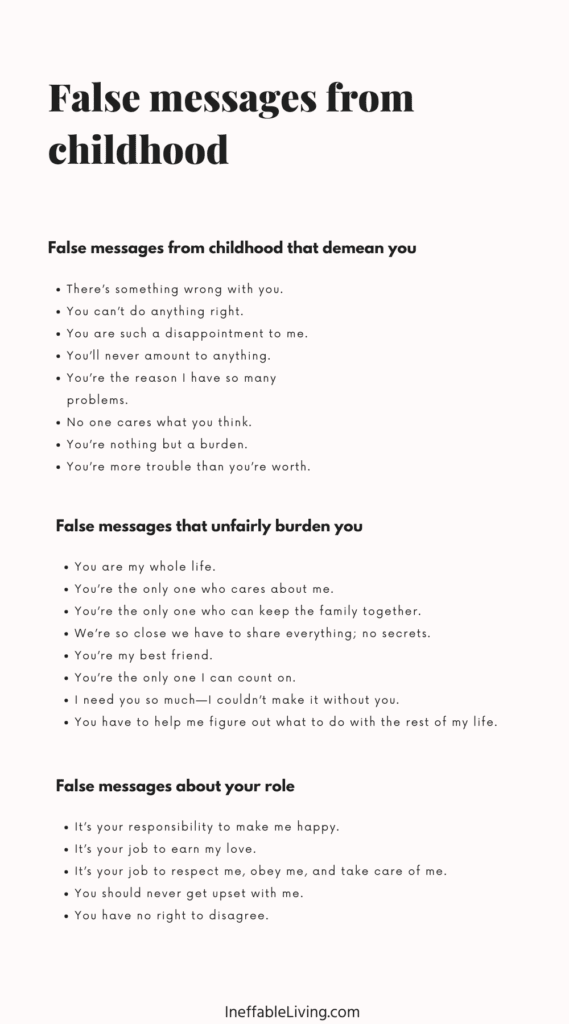
Exercise 4. Accept the Wounded Inner Child
The more we fight against ourselves, the more suffering we inflict on ourselves.
However, self-acceptance doesn’t mean you have to like everything about yourself.
Self-acceptance means acknowledging what there is—the good and the bad, the strengths and the limitations.
It’s only when you acknowledge these limitations that you can work on them, if you choose to do so.
1. Close your eyes and try to recite your negative beliefs or it may be easier to recall an incident where your inner child was very reactive.
2. Allow yourself to feel whatever comes up (fear, rage, insecurity, or sorrow.)
3. Take a deep breath and say to yourself “Yes, that’s my dear wounded child. You’re allowed to be here, just as you are. I welcome you.”
Feeling your painful emotions is a form of self-soothing that will help you reduce the intensity of those emotions.
The more your wounded child feels seen, accepted, and understood, the calmer he/she will become.
Related: Inner Teenager Healing: 14 Proven Exercises to Heal Your Inner Teenager and Wounded Inner Child
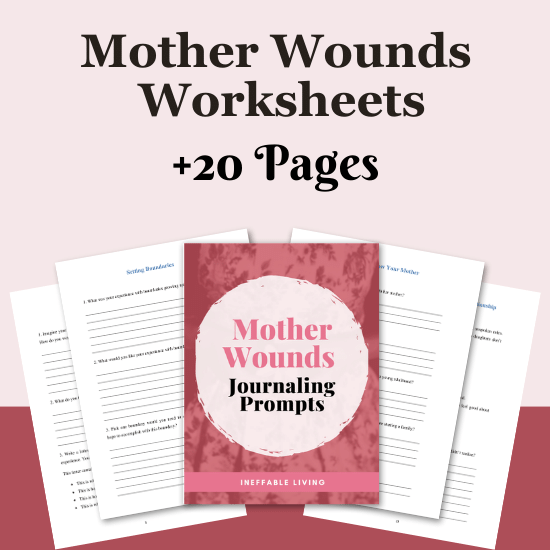
Exercise 5. Understand Your Wounded Child’s Perspective
Understanding your wounded child’s perspective will help you separate your inner adult from the wounded child’s perception, allowing you more freedom in your decisions and actions.
1. Choose a problem you’re struggling with. Place two chairs facing each other. Sit down on one chair and try to channel your inner child.
Allow the inner child to describe the problem and express his/her feelings and thoughts about this problem.
2. Then switch to the other chair to summon your inner adult and try to analyze the problem using your own rational mind.
If you have a problem saying no to someone, you may discover that you’re not trying to be polite and that it’s the wounded child’s fear of rejection that’s preventing you from asserting yourself.
You can do this exercise in writing, using different pens for the wounded child and the inner adult.
Exercise 6. Non Dominant Hand Exercise
In this exercise, you’re going to communicate with your inner child using both hands.
Here is how to do it:
1. Find a place where you won’t be interrupted and allow yourself to relax and clear your mind by taking a few deep breaths.
2. Take an exercise book. Use your usual writing hand to write as the inner parent part of you on the page that matches that hand. (i.e. right hand – use right page)
Then change your pen over to the opposite hand and write your response on the opposite page.
If you’re left-handed, simply reverse all the above directions.
Guidelines:
1. Begin with your usual writing hand and try writing something positive about your inner child ‘You are …….’ or simply write a reassuring welcome message to your Inner Child.
2. Then change your pen over to the opposite hand and let the pen do whatever it wants to do, be it writing, drawing, or even doodling.
Keep a non-judgmental, compassionate attitude as you do this and allow yourself to take as much time as you need.
3. Change your pen over to your dominant hand and respond to whatever the other hand said or drew on its page. Then try asking an easy question in the way you would for a child.
Avoid logical or “why” questions that would distress a small child.
4. Keep going backwards and forwards from one side to the other and for as long as you or your inner child wants to.
5. When you end the sessions, close with reassuring, soothing statement from your dominant hand, especially if the Inner child has expressed fear or vulnerable feelings.
Related: Top +100 Journal Prompts For Mental Health [+Free PDF Printable!]
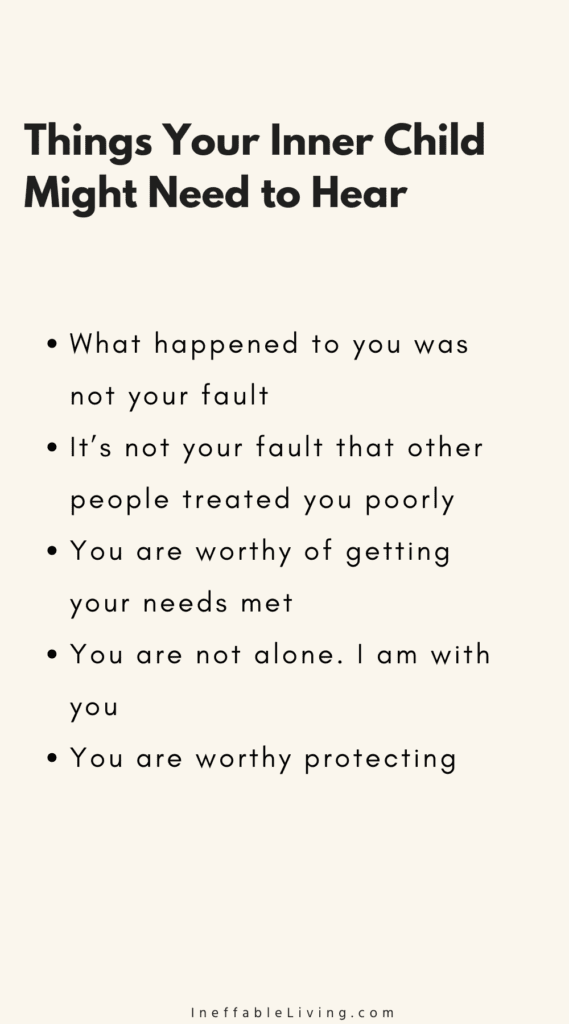
Exercise 7. Use Art therapy
Expressive art therapy is incredibly healing because it can go to the parts of the brain in the limbic system that words don’t. (*)
This is mainly because language is connected to the left side of the brain, whereas emotions are stored in the right side of the brain.
1. Get a piece of paper and crayons and try to relax by taking a few deep breaths.
2. Close your eyes and see your inner child in your mind. Notice the color of his/her hair, posture, clothing and demeanor.
If the inner child is angry, sad or frightened, withhold judgment and welcome him/her and his/her authentic feelings.
3. Draw a picture of the inner child using your non-dominant hand as to allow the inner child to express himself or herself.
4. Use crayons to color the areas of the body where the child feels pain and discomfort using colors associated with that sensation.
For example, you may use the color red or orange to show burning sensation.
5. Thank the child for sharing with you.
Exercise 8. Strengthen Your Adult-Self
To heal your wounded child, you’ll need a strong, resilient inner adult who understands that the negative beliefs are simply the result of childhood influences and who can challenge those negative beliefs.
Here is a list of facts and arguments to use along the way:
- No child is born bad. Children can be exhausting, but this doesn’t affect their value. It is the parents’ responsibility to consider whether they want to take on the stress of parenthood before deciding to become parents.
- Children have the right to have their physical and emotional needs met and it is the parents’ duty to understand their children’s needs and fulfill them.
- Children are more or less powerless. It is the parents’ responsibility to meet their children’ needs. If parents are overwhelmed by the task of meeting their children’s needs, they should ask for help.
- It is the parents’ responsibility to love their children unconditionally and make them feel welcome and accepted. Children should not feel they need to behave in a certain way for them to earn love and acceptance.
Choose a negative belief from the list you uncovered previously and try challenging that belief.
You may find it helpful to answer the following questions as you challenge your beliefs:
- What evidence do I have that what I believe is not true?
- Am I blaming myself for something which is not really my fault?
- Am I taking something personally which has little or nothing to do with me?
- What would I tell a friend if he/she had the same belief?
Related: How to Build Emotional Resilience? Top 10 Powerful Ways to Stay Healthy and Happy During Tough Times
Exercise 9. Nurture Your Inner Child
Allow yourself to feel compassion towards the inner child:
1. Look at your childhood pictures of yourself or imagine you are speaking to a scared little kid. Imagine how you’d comfort him/her.
2. Explain to the wounded inner child how things were back then at home, using details from your own childhood.
For example, you might say “Mom was always overwhelmed. You tried not to be a burden. You thought ‘I am a burden,’ ‘I am not good enough.’ But you could never, nor was it your responsibility to make Mom happy.”
Addressing your wounded child, try using a child’s vocabulary, as if you’re talking to a real child. Words like “depressed” could be replaced with words like “sad,” or, “upset.”
3. Explain to the wounded child that none of this was its fault and things would have been so different had Mom and Dad not been so overwhelmed.
You can say something like “Mom and Dad had made some mistakes. Had they not been so overwhelmed, you would have realized that you’re good enough and loved just the way you are. If you were a burden sometimes, that is okay – it’s the way children are. It’s the parents’ responsibility to take care of and meet their children’s needs.”
Exercise 10. Mirror exercise
Mirror exercise helps you directly connect with and talk to your inner child. It’s also a powerful way to affirm your inner child.
1. Stand in front of a mirror, place your hand on your heart or hug yourself and gaze softly at yourself.
2. Feel the presence of your inner child in your eyes and observe the inner child inside of you.
3. Allow yourself to feel love and compassion towards your inner child and let him/her know that you’re there for him/her.
4. Try saying something loving or comforting, such as “I see you”, “I’m here now’, “I’m so proud of you”, “I think you’re brave”.
Other things you can say are:
“It’s okay sweetheart, I’m here”
“I care about you”
“I hear you”
“Your emotions are valid”
“Your emotions are welcomed here”
“It’s okay to feel what you’re feeling”
“What is on your mind? I’m here to listen”.
Exercise 11. Allow The Inner Adult To Take Control
When a child is afraid to go to school on the first day, the adult won’t let the child stay at home and will instead hold their hand and help them adapt.
You can approach your inner child in the same way: allow it to express itself, but ultimately, you’re the one making the rational decisions.
When you catch yourself governed by your wounded child, believing everything you think and feel, try to switch back to your adult self and work on comforting the wounded child with soothing words and touch.
Get back in touch with your current reality, in which you are an adult dealing with people who are not your mom and dad.
The more you practice being attentive to yourself, the faster you’ll become at catching yourself when you retreat to your wounded inner child.
Related: How To Stop Feeling Sorry For Yourself? 10 Powerful Ways To Get Out Of Self-Pity
Exercise 12. Amplify The Positive, Bonding Moments
You can use your imagination to amplify the positive, bonding ones.
Reflect on memories from your childhood you experienced with your parents that were nice, warm, and loving.
Allow yourself to feel that sense of warmth, connection, and security.
If you can’t think of positive memories you’ve shared with your parents, try picking out imaginary parents, whether they are real people or imaginary figures.
Imagine the parents you wished you had. Close your eyes and visualize the child you were back then being cared for and loved by those loving parents.
Allow yourself to feel the connection and security with your new parents.

Exercise 13. Discover Your Positive Beliefs
Try to think of positive beliefs you adopted from your parents.
Write down positive traits they had and things they did right.
If you’d rather not include your parents because your relationship with them is or was difficult, you may skip this part of the exercise.
You can also think of other adults in your life: a loving grandma, a kind teacher or neighbor who showed you understanding and support as a child.
Here’s a list of some positive beliefs:
- I am loved
- I am valuable
- I am welcome
- I have a right to be happy
- I am allowed to be a burden sometimes
- I am allowed to be me
- I am allowed to defend myself
- I am allowed to feel
- I am allowed to have my own opinions
- I am allowed to make mistakes
- I am allowed to set boundaries
Once you identified a set of positive beliefs, go back to your list of negative beliefs and try to turn these into positives.
For example, the belief that “I’m inadequate,” can become, “I’m good enough.” The belief that “I’m worthless,” becomes, “I’m valuable.”
Don’t include a negative like “not,” in your positive beliefs.
This is because our subconscious can’t to tell the difference between “I’m inadequate,” and “I’m not inadequate,” for example.
It is hard not to think of something. When I say, “Don’t think of a pink elephant,” you’ll automatically start thinking of one.
Make your positive beliefs reasonable
Add words like “enough” or narrow the belief down:
A belief like “I’m worthless,” is better turned into, “I’m worthy enough.”
A belief like “I’m not important,” is better turned into, “I’m important to my partner and children.”
Exercise 14. Rewrite Old Memories
Studies show that the mind does not differentiate between reality and imagination. (*)
For instance, imagining an anxiety-provoking situation, such as an upcoming job interview can be as anxiety-provoking as going for the real interview.
This is good news because you can use imagination to rewrite painful past memories. (*)
1. Recall a memory from your childhood that reflects the negative beliefs of your inner child.
Try to remember an incident that doesn’t trigger debilitating feelings, as to overwhelm you and try not to immerse yourself fully in it.
For example, if your mother abused you physically, it’s enough to imagine her raising her hand and stop there.
2. Try to experience the memory from the inner child’s perspective: Feel what the child felt, but don’t fully immerse yourself in the feelings.
Use an anchor to help you stay present, such as your breath, or simply leave your eyes open and focus on an object in front of you while you revisit the incident.
3. Imagine being rescued by a helper who shows up. It can be a real person or a fictional character.
Related: Trauma Release Exercises: Top 6 Practical Exercise to Support Healing After Trauma
Exercise 15. Write Your Wounded Child a Letter
Visualize the inner child standing in front of you and think about all the loving things you wish to tell him or her.
You might find it helpful to look at a childhood picture while you do so.
Related: Best Edith Eger Quotes (“The Gift”): 12 Invaluable Lessons to Set Yourself Free
Pro Tip. Work With a Therapist
There is a lot that you can do to support your healing journey.
But healing your inner child alone can be an overwhelming thing to do on your own, especially when the emotional turmoil has been repressed for a long time.
Consider working with a therapist to support you on your healing journey.
To find a mental health care provider near you, call 1-800-662-HELP (4357) or you can use online therapy.
Online therapy is much affordable than in-person therapy, but can be equally effective. (source)
FAQ
Does everyone have an inner child?
It is clear that we all have an Inner Child.
However, most people aren’t aware of its existence.
When life is fairly easy and we’re not facing any major problems, this lack of awareness might not be a problem.
But when there is a personal crisis, being out of touch with our inner child can cause our painful emotions to take over and prevent us from finding our way out.
Is inner child work evidence based?
There is some evidence to suggest that inner child work can be effective for certain individuals in improving their emotional well-being and relationships.
However, it is important to note that the concept of the inner child is not a scientifically recognized term or approach in mainstream psychology.
The effectiveness of inner child work may depend on the individual’s belief system, interpretation, and willingness to engage in the process.
It is always best to consult with a licensed mental health professional who is experienced in this area if you are interested in exploring inner child work.
How does trauma affect the inner child?
The inner child is the part of us that carries our early experiences, memories, and emotions.
When we experience trauma in childhood, it can cause the inner child to feel scared, abandoned, helpless, and overwhelmed.
This can lead to the development of negative core beliefs about ourselves, others, and the world, such as feeling unlovable, unworthy, or unsafe.
The inner child may also be triggered by situations or events that remind them of the traumatic experience, leading to feelings of anxiety, depression, or flashbacks. These reactions are often automatic and can be difficult to control.
It is essential to address and heal the inner child’s trauma to promote overall healing and well-being.
This can involve therapy, self-care practices, and building healthy relationships that provide safety, support, and validation.
Ultimately, helping the inner child heal can lead to greater levels of self-love, self-acceptance, and resilience.
Why do we need an inner child?
Our inner child represents our most innocent, playful, and creative self.
It embodies the wonder, joy, and curiosity we had as children before we learned to conform to societal expectations or experienced emotional pain or trauma.
As we grow older, we often neglect our inner child, which can lead to feelings of disconnect, boredom, anxiety, and depression.
By reconnecting with our inner child, we can tap into a wellspring of creativity, intuition, and imagination that can help us navigate life’s challenges with greater ease and joy.
Our inner child reminds us to play, laugh, and enjoy life’s simple pleasures, which can help us stay grounded, balanced, and fulfilled.
How long does inner child healing take?
The length of time it takes for inner child healing can vary depending on the individual and their unique experiences.
Some people may find that a few sessions with a therapist or counselor can provide significant progress, while others may require more extensive therapy.
It’s important to approach healing with patience and understanding that it is a process that takes time.
It’s also essential to prioritize self-care, establish healthy boundaries, and seek support from trusted individuals throughout the healing journey.
Can I do inner child healing on my own or do I need a professional’s help?
You can definitely do inner child healing on your own, but it may be helpful to have the guidance of a professional if you feel stuck or overwhelmed during the process.
Working with a therapist, counselor or healer can provide you with a safe and supportive space to explore your emotions, memories, and beliefs related to your inner child.
They can also help you establish healthy coping mechanisms and offer you tools to continue the healing process outside of therapy sessions.
Inner Child Healing Exercises PDF
References
- Inner child – Wikipedia
- 8 Tips for Healing Your Inner Child (healthline.com)
- Inner Child: Healing Your Inner Child | BetterHelp
- What Is Inner Child Work? A Guide To Healing Your Inner Child | mindbodygreen
- Health throughout the lifespan: The phenomenon of the inner child reflected in events during childhood experienced by older persons – PMC (nih.gov)
- The Wounded Inner Child | CPTSDfoundation.org


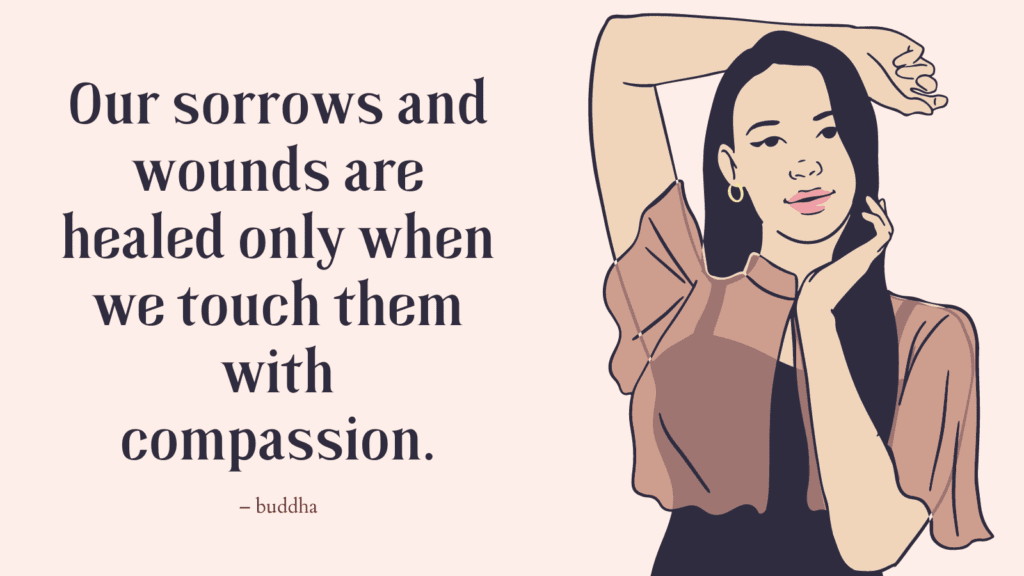
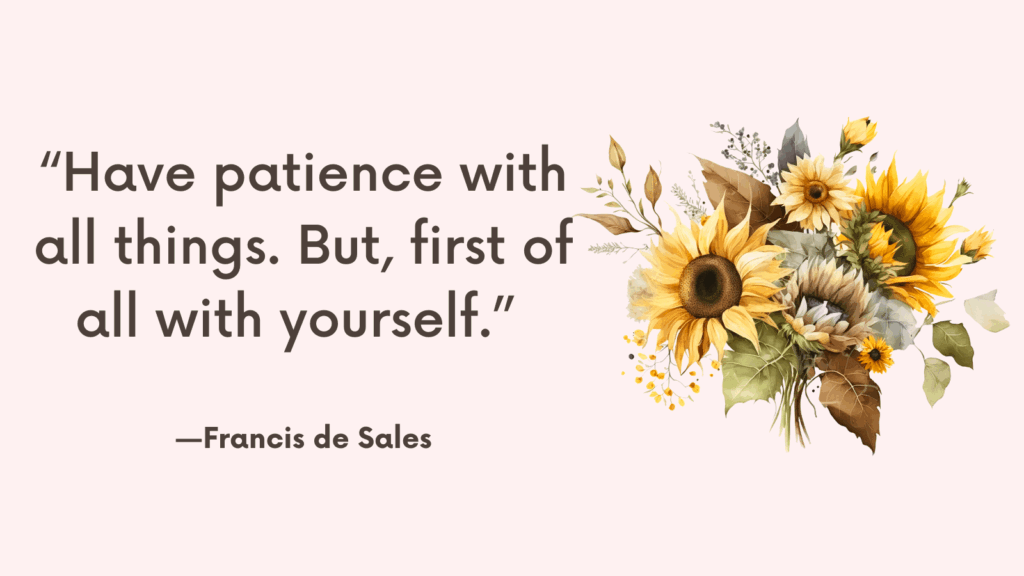
Comments are closed.